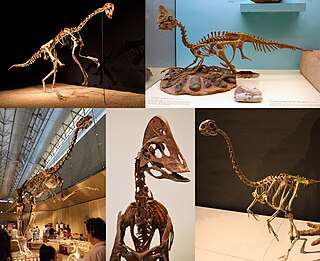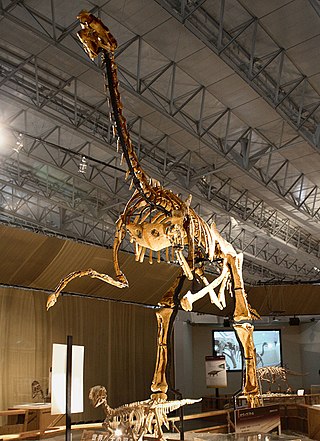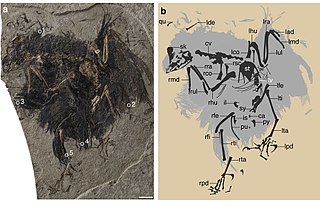
Oviraptoridae is a group of bird-like, herbivorous and omnivorous maniraptoran dinosaurs. Oviraptorids are characterized by their toothless, parrot-like beaks and, in some cases, elaborate crests. They were generally small, measuring between one and two metres long in most cases, though some possible oviraptorids were enormous. Oviraptorids are currently known only from the Late Cretaceous of Asia, with the most well-known species and complete specimens found only in the Gobi Desert of Mongolia and northwestern China.

Confuciusornis is a genus of basal crow-sized avialan from the Early Cretaceous Period of the Yixian and Jiufotang Formations of China, dating from 125 to 120 million years ago. Like modern birds, Confuciusornis had a toothless beak, but closer and later relatives of modern birds such as Hesperornis and Ichthyornis were toothed, indicating that the loss of teeth occurred convergently in Confuciusornis and living birds. It was thought to be the oldest known bird to have a beak, though this title now belongs to an earlier relative Eoconfuciusornis. It was named after the Chinese moral philosopher Confucius. Confuciusornis is one of the most abundant vertebrates found in the Yixian Formation, and several hundred complete specimens have been found.

The Enantiornithes, also known as enantiornithines or enantiornitheans in literature, are a group of extinct avialans, the most abundant and diverse group known from the Mesozoic era. Almost all retained teeth and clawed fingers on each wing, but otherwise looked much like modern birds externally. Over eighty species of Enantiornithes have been named, but some names represent only single bones, so it is likely that not all are valid. The Enantiornithes became extinct at the Cretaceous–Paleogene boundary, along with Hesperornithes and all other non-avian dinosaurs.

Beipiaosaurus is a genus of therizinosauroid theropod dinosaurs that lived in Asia during the Early Cretaceous in the Yixian Formation. The first remains were found in 1996 and formally described in 1999. Before the discovery of Yutyrannus, Beipiaosaurus were among the heaviest dinosaurs known from direct evidence to be feathered. Beipiaosaurus is known from three reported specimens. Numerous impressions of feather structures were preserved that allowed researchers to determine the feathering color which turned out to be brownish.

Oviraptorosaurs are a group of feathered maniraptoran dinosaurs from the Cretaceous Period of what are now Asia and North America. They are distinct for their characteristically short, beaked, parrot-like skulls, with or without bony crests atop the head. They ranged in size from Caudipteryx, which was the size of a turkey, to the 8-meter-long, 1.4-ton Gigantoraptor. The group is close to the ancestry of birds. Some researchers such as Maryanska et al (2002) and Osmólska et al. (2004) have proposed that they may represent primitive flightless birds. The most complete oviraptorosaur specimens have been found in Asia. The North American oviraptorosaur record is sparse.

Avimimus, meaning "bird mimic", is a genus of oviraptorosaurian theropod dinosaur, named for its bird-like characteristics, that lived in the late Cretaceous in what is now Mongolia, around 85 to 70 million years ago.

Nomingia is a genus of oviraptorosaur theropod dinosaur hailing from the Late Cretaceous Bugin Tsav Beds of Mongolia.

Citipati is a genus of oviraptorid dinosaur that lived in Asia during the Late Cretaceous period, about 75 million to 71 million years ago. It is mainly known from the Ukhaa Tolgod locality at the Djadochta Formation, where the first remains were collected during the 1990s. The genus and type species Citipati osmolskae were named and described in 2001. A second species from the adjacent Zamyn Khondt locality may also exist. Citipati is one of the best-known oviraptorids thanks to a number of well-preserved specimens, including individuals found in brooding positions atop nests of eggs, though most of them were initially referred to the related Oviraptor. These nesting specimens have helped to solidify the link between non-avian dinosaurs and birds.

Jeholornis is a genus of avialan dinosaurs that lived between approximately 122 and 120 million years ago during the early Cretaceous Period in China. Fossil Jeholornis were first discovered in the Jiufotang Formation in Hebei Province, China and additional specimens have been found in the older Yixian Formation.

Caudipteridae is an extinct family of oviraptorosaurian dinosaurs known from the Early Cretaceous of China. Found in the Yixian and Jiufotang Formations, the group existed between 125 and 120 million years ago. Distinguishing characteristics of this group have been indicated as including a unique dagger-shaped pygostyle. In 2015, the group was defined as "the most inclusive clade containing Caudipteryx zoui but not Oviraptor philoceratops and Caenagnathus collinsi".

Sapeornis is a monotypic genus of avialan dinosaurs which lived during the early Cretaceous period. Sapeornis contains only one species, Sapeornis chaoyangensis.

Gigantoraptor is a genus of large oviraptorosaur dinosaur that lived in Asia during the Late Cretaceous period. It is known from the Iren Dabasu Formation of Inner Mongolia, where the first remains were found in 2005.

Confuciusornithidae is an extinct family of pygostylian avialans known from the Early Cretaceous, found in northern China. They are commonly placed as a sister group to Ornithothoraces, a group that contains all extant birds along with their closest extinct relatives. Confuciusornithidae contains four genera, possessing both shafted and non-shafted (downy) feathers. They are also noted for their distinctive pair of ribbon-like tail feathers of disputed function.

Ornithurae is a natural group which includes the common ancestor of Ichthyornis, Hesperornis, and all modern birds as well as all other descendants of that common ancestor.

Pygostylia is a group of avialans which includes the Confuciusornithidae and all of the more advanced species, the Ornithothoraces.
Zhongornis is a genus of primitive maniraptoran dinosaurs that lived during the Early Cretaceous. It was found in rocks of the Yixian Formation in Lingyuan City (China), and described by Gao et al. in 2008.

Similicaudipteryx, meaning "similar to Caudipteryx", is a genus of theropod dinosaur of the family Caudipteridae.

Shanweiniao is a genus of long-snouted enantiornithean birds from Early Cretaceous China. One species is known, Shanweiniao cooperorum. There is one known fossil, a slab and counterslab. The fossil is in the collection of the Dalian Natural History Museum, and has accession number DNHM D1878/1 and DNHM1878/2. It was collected from the Lower Cretaceous Dawangzhengzi Beds, middle Yixian Formation, from Lingyuan in the Liaoning Province, China.

Euornithes is a natural group which includes the most recent common ancestor of all avialans closer to modern birds than to Sinornis.

Cruralispennia is an extinct genus of enantiornithean bird. The only known specimen of Cruralispennia was discovered in the Early Cretaceous Huajiying Formation of China and formally described in 2017. The type species of Cruralispennia is Cruralispennia multidonta. The generic name is Latin for "shin feather", while the specific name means "many-toothed". The holotype of Cruralispennia is IVPP 21711, a semi-articulated partial skeleton surrounded by the remains of carbonized feathers.




















